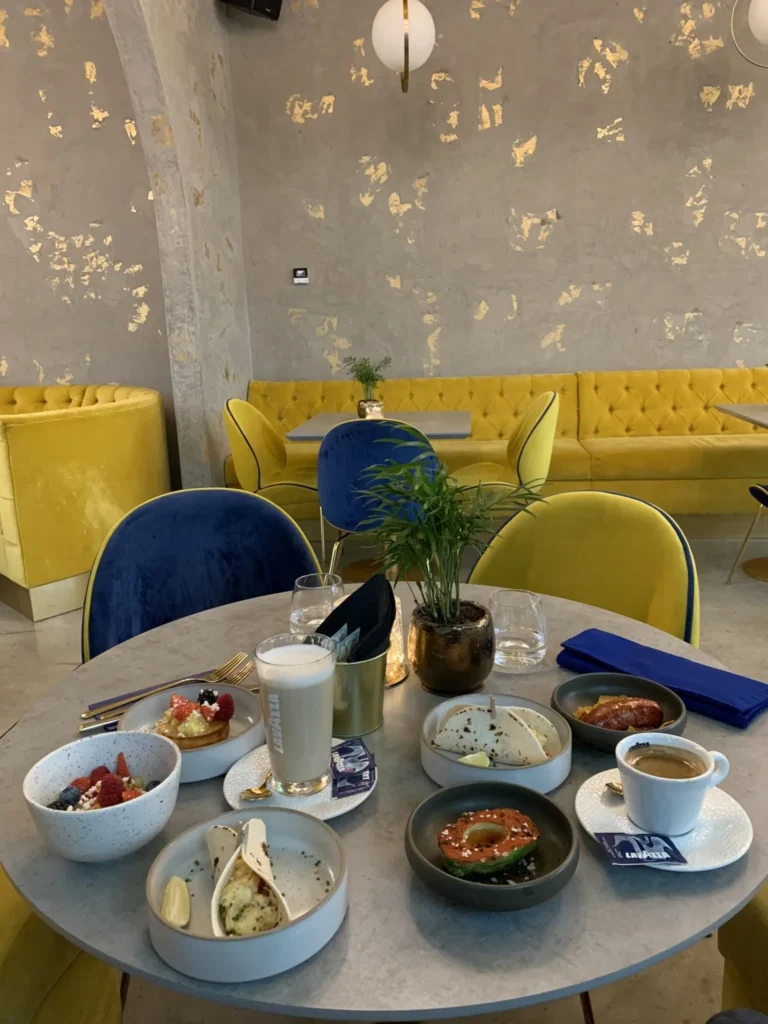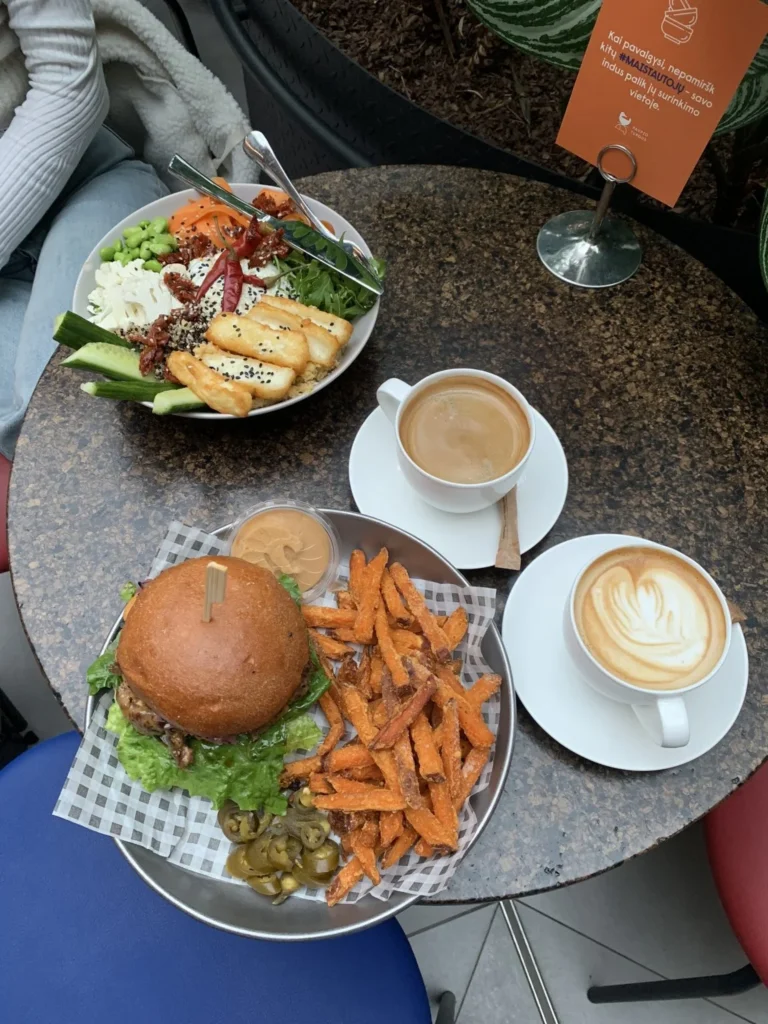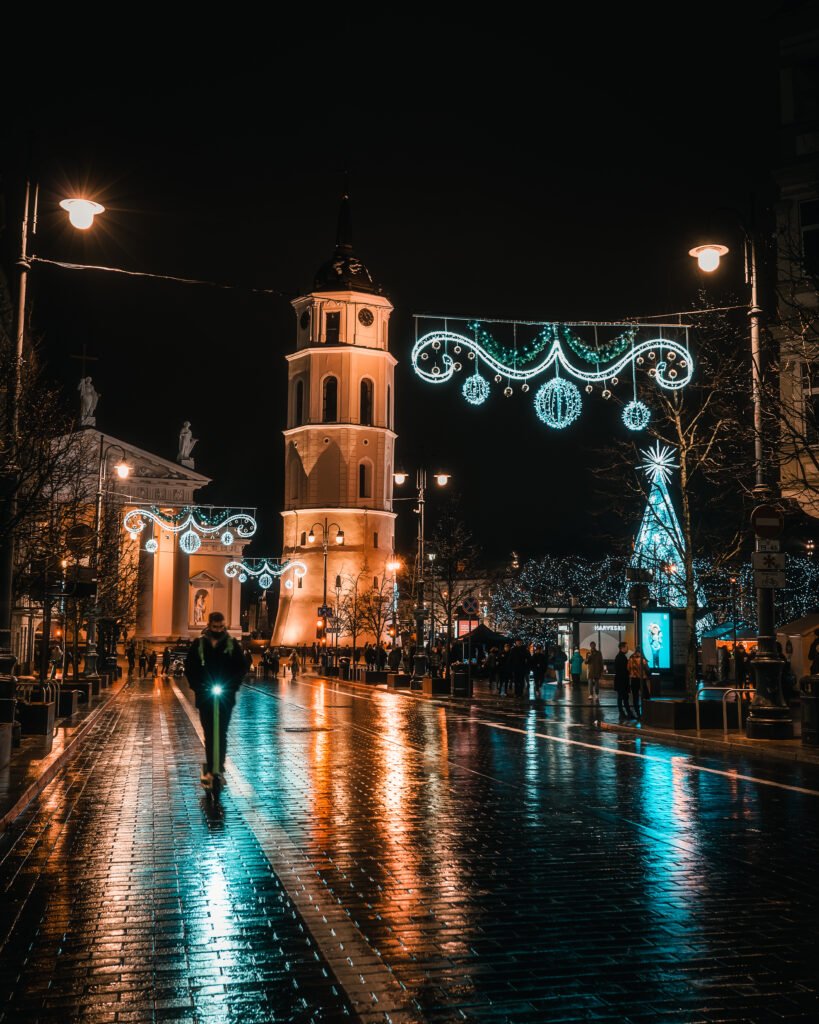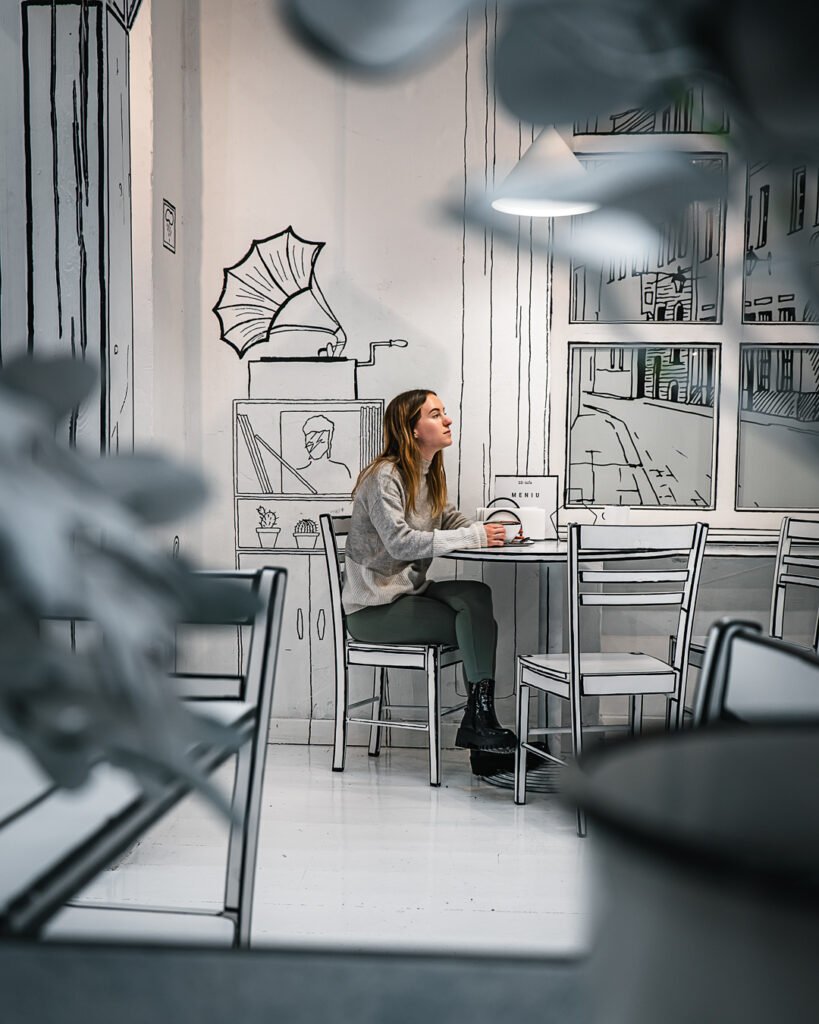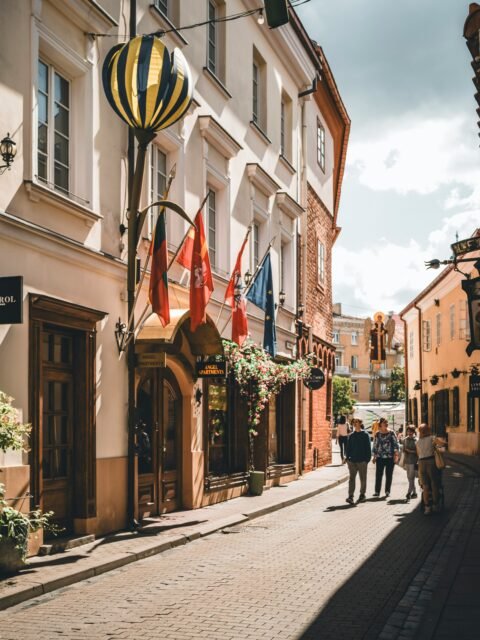Before you head off on your trip Lithuania’s charming capital of Vilnius, it’s helpful to be aware of a few key details that will make your trip more enjoyable and stress-free. From the best time to visit to navigating the city’s public transport, here are the essential things you need to know before heading to Vilnius.
1. How to get around Vilnius?
Vilnius is relatively easy to navigate, thanks to its compact size and well-structured public transport system. Here’s what to expect:
Public Transport
Vilnius has an efficient bus and trolleybus system. Tickets can be purchased via mobile apps or at kiosks. Public transport is affordable and reliable, with frequent service throughout the city and to the suburbs.
Walking
The city centre is walkable, with many attractions located within a short distance from each other. The Old Town’s cobblestone streets are ideal for a stroll, though comfortable shoes would be recommended.

Cycling
Vilnius is becoming more bike-friendly, with bike lanes in some parts of the city. You can rent bikes or use the city’s bike-sharing service, CycloCity.
For most people, walking and public transport will be a convenient way to get around Vilnius. If you plan to explore the surrounding countryside, consider renting a car for greater convenience.
Do you need to hire a car in Vilnius?
Whether or not you need to rent a car in Vilnius depends largely on your travel plans and how much of Lithuania you intend to explore. Here’s what you should consider:
Pros of renting a car in Vilnius:
- Flexibility: Renting a car gives you the freedom to explore beyond Vilnius at your own pace. The city itself is very walkable, but a car is useful if you plan to visit nearby attractions like Trakai Castle or the Hill of Crosses.
- Day Trips: Lithuania has several charming towns and natural parks within driving distance of Vilnius. With a car, you can easily access these sites without relying on tour schedules.
Cons of renting a car in Vilnius:
- City Traffic: Like any other city, Vilnius can get congested, especially during peak hours. Parking in the city centre can also be challenging and often requires a fee.
- Public Transport: The city has an excellent public transport system, including buses and trolleybuses, making it easy to get around without a car.
If your plan is to stay mainly within Vilnius or take guided tours to nearby sites, you likely won’t need a car. However, if you prefer to venture out on your own, renting a car offers flexibility and convenience.
2. What is the food like in Vilnius?
We found Vilnius’ dining scene to be impressive, offering everything from Michelin star restaurants to vegan cafes. Whether you’re looking for a relaxed meal or a fine dining experience, Vilnius has plenty of options to rival other European capitals.
If you’re looking for quality local cuisine, restaurants like Nineteen18 and Džiaugsmas are known for their innovative approach to Lithuanian cuisine, blending local ingredients with creative techniques.
For a more relaxed experience, make sure to visit Paupys Market. This modern food hall is a hotspot for both locals and touists, offering a wide range of international and local dishes in a beautiful market-style setting. It’s the perfect place to sample different cuisines all under one roof.
3. When is the best time to visit Vilnius?
The best time to visit Vilnius depends on your interests and what you want to experience. Here’s what you can expect throughout the year:
Spring (April to June)
Spring is one of the most beautiful times to visit Vilnius. The weather is mild, and the city’s parks and gardens are in full bloom. It’s an ideal time for sightseeing and outdoor activities.
Summer (July to August)
Summer is the peak tourist season, with warm temperatures averaging between 20°C and 25°C (68°F to 77°F). The city is lively, with festivals, open-air events and bustling cafes. However, expect more crowds.
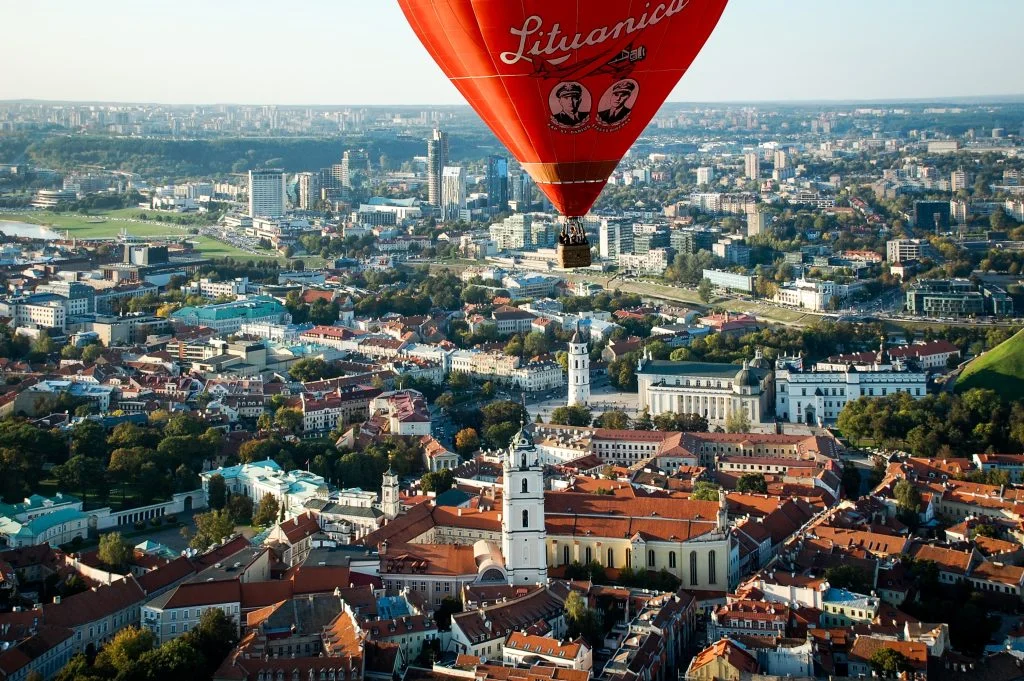
Vilnius is famous for it’s hot air balloon rides and summer is the best time to experience it for yourself – as this is such a weather depenent activity, you’re chances of success are much higher in the summer months!
Autumn (September to November)
Autumn brings cooler temperatures and fewer tourists. The autumn foliage makes the city particularly picturesque. It’s also a great time for cultural activities, as the theatre season kicks off.
Winter (December to February)
Winter in Vilnius is cold, with temperatures often dropping below freezing. However, the city’s Christmas markets and festive decorations create a magical atmosphere. If you don’t mind the cold, it’s definitely one of the best times to visit!
4. Is Vilnius Expensive?
Vilnius is generally more affordable than many Western European capitals. Here’s a breakdown of typical costs:
Accommodation Costs:
- Budget: Hostels and budget hotels range from €20 to €50 per night.
- Mid-Range: Comfortable hotels and guesthouses typically cost between €50 and €100 per night.
- Luxury: High-end hotels range from €100 to €200 per night, with some boutique options available in the heart of the Old Town.
Food Costs:
- Local Eateries: You can enjoy a meal at a local café for around €5 to €10.
- Mid-Range Restaurants: Expect to pay between €10 and €20 per person for a meal at a mid-range restaurant.
- Fine Dining: Upscale dining can cost €30 or more per person.
Transportation Costs:
Public transport is very affordable, with single tickets costing around €1, or you can get a day pass for about €5.
Overall, Vilnius offers good value for money, making it an attractive destination for budget-conscious travellers as well as those looking for more luxurious experiences.
5. Do they Speak English in Vilnius? What Language do they Speak?
Lithuanian is the official language in Vilnius, but English is widely spoken, especially in tourist areas, hotels and restaurants.
Learning a few basic Lithuanian phrases can enhance your experience and show respect for the local culture – here are a few helpful phrases to get you started:
- Hello: Labas
- Thank You: Ačiū
- Please: Prašau
- Yes: Taip
- No: Ne
- Good Morning: Labas rytas
6. What Currency Is Used in Vilnius?
Lithuania uses the Euro (EUR, €). Here are some tips for handling money during your visit:
- Cash and Cards: Credit and debit cards are widely accepted in Vilnius, including in most shops, restaurants, and hotels. However, it’s always a good idea to carry some cash, especially for smaller purchases or in more remote areas.
- ATMs: There are plenty of ATMs throughout the city, and they typically accept international cards. Be aware of possible transaction fees, depending on your bank.
Tipping: Tipping is not obligatory in Lithuania, but rounding up the bill or leaving a small tip (about 5-10%) is appreciated in restaurants and cafes.
7. What Plug Type Is Used in Vilnius?
Vilnius, like the rest of Lithuania, uses Type C and Type F outlets, which are common in most European countries. These outlets have two round pins, and the voltage is 230V with a frequency of 50Hz. If you’re coming from outside of Europe, make sure you don’t forget your travel adapter!
8. Where Are the Best Places to Stay in Vilnius?
Where you stay in Vilnius will depend on your interests and what you want to experience. Here’s a guide to some of the best areas:
For History and Culture
Old Town: Staying in Vilnius Old Town puts you in the heart of the city’s historical and cultural sites. Here, you’ll find a mix of boutique hotels, guesthouses, and luxury accommodations, all within walking distance of major attractions like Gediminas Tower and Vilnius Cathedral.
For a Relaxed Atmosphere
Uzupis: Known as Vilnius’ bohemian district, Uzupis offers a unique and artistic vibe. It’s a great place to stay if you want to explore quirky cafes, art galleries, and enjoy a more laid-back atmosphere. There are several charming guesthouses and boutique hotels in this area.
For Nature and Tranquillity
Antakalnis: If you prefer a quieter environment with access to nature, consider staying in Antakalnis. This residential district is close to parks and offers a more serene setting while still being a short ride from the city centre.
9. How Long Do You Need to Explore Vilnius?
Vilnius is a compact city, and you can see the main attractions in 2-3 days. However, if you want to explore the surrounding areas or simply enjoy the city at a leisurely pace, 4-5 days would be ideal.
Itinerary Suggestions:
- 2-3 Days: Focus on exploring the Old Town, Gediminas Castle, Vilnius Cathedral and the Republic of Uzupis.
- 4-5 Days: Include day trips to Trakai Castle, explore local markets and venture into nearby parks and forests.
10. How to get from the airport to the city?
When you arrive in Vilnius, getting from the airport to the city centre is straightforward and convenient. Vilnius Airport (VNO) is located just 6 kilometres (about 3.7 miles) south of the city centre, and you have several options for making the short journey:
Public Transport
The most budget-friendly option is taking a bus. Buses run regularly from the airport to various parts of the city, including the central bus station and key locations in the city centre. Bus routes like 88 and 3G are popular choices, with a journey time of around 15-20 minutes.
There’s also a train service that connects Vilnius Airport to the main train station in the city centre. The train ride takes just 7 minutes, making it one of the fastest ways to reach downtown Vilnius.

Taxi or Ride-Sharing
Taxis are readily available outside the terminal, and the ride to the city centre typically takes 10-15 minutes. Ride-sharing services like Bolt and Uber are also available, offering a convenient and reasonably priced alternative to taxis.
Alternatively, you could book a private airport transfer in advance to avoid any hassle when you land.
Book your adventure



